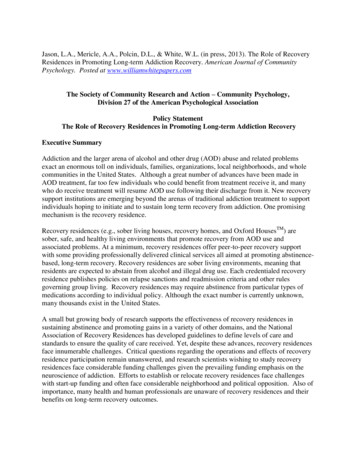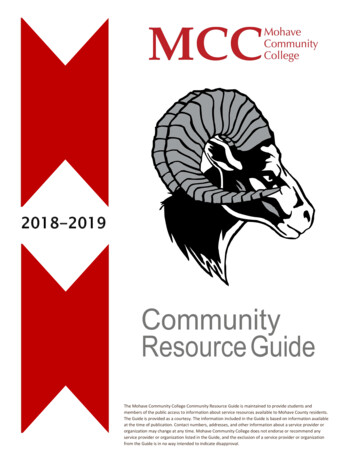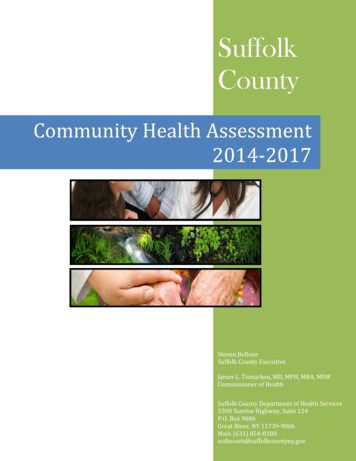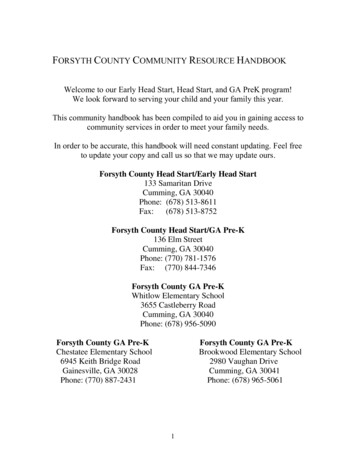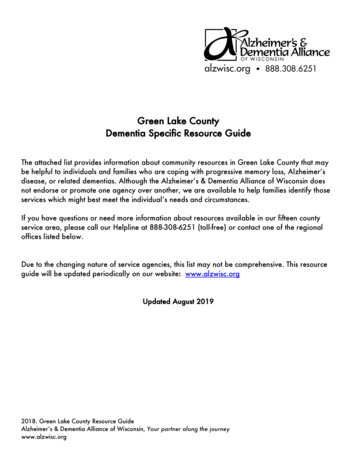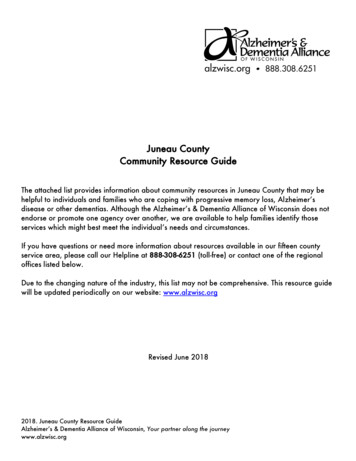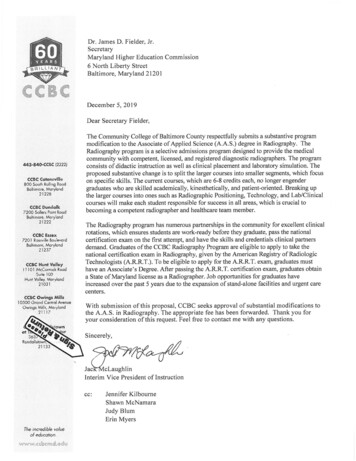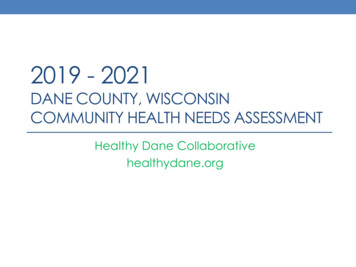
Transcription
2019 - 2021DANE COUNTY, WISCONSINCOMMUNITY HEALTH NEEDS ASSESSMENTHealthy Dane Collaborativehealthydane.org
Message to the CommunityDane County has a unique history of collaboration between local health care providers.For many years, our organizations have worked together in order to leverage ourcombined resources and address the health concerns of our community. In 2012, membersof the Dane County Health Council came together to develop a joint health needsassessment under the name Healthy Dane Collaborative. Since the development of the2012 Community Health Needs Assessment (CHNA), the Healthy Dane Collaborativecontinues to work together to pursue collaborative approaches aimed at improving thehealth of Dane County.This 2019-2021 CHNA was collaboratively completed in 2018 by Healthy Dane partners:Group Health Cooperative, Public Health Madison Dane County, SSM Health-St. Mary’s,Stoughton Hospital, UnityPoint Health-Meriter and UW Health. It combines populationhealth data in addition to feedback gathered from the community through communityinput sessions and interviews to present a big-picture view of the factors impacting thehealth of our community. While many indicators of health are positive overall, it is apparentthat specific populations in Dane County, specifically communities of color, experiencesignificant inequities in terms of social and economic opportunities and health outcomes.The Healthy Dane Collaborative recognizes the health needs of the community and theresources available are constantly evolving. The CHNA can serve as a valuable guidepostto establish shared priorities and as a benchmarking tool as we continue to create ahealthier Dane County.The Healthy Dane Collaborative is proud to share this CHNA with the community.2
Healthy Dane Collaborative health.orgHealthy Dane Collaborativehealthydane.org3
Contents of this Report1. Dane County Profile2. Community Needs and Assets3. Priority Issues4. Additional Resources4
PART 1:DANE COUNTY PROFILE
History of the Land The Ho-Chunk Nation, People of the BigVoice, have long occupied land inWisconsin extending from Green Baybeyond Lake Winnebago to the WisconsinRiver and even to the Rock River in Illinoisamounting to 8.5 million acres.1 Due to lead mining in the late 1820s, theHo-Chunk were forced to leave Wisconsinand sell their land to the U.S. Government.Over time, many returned to Wisconsinand had to repurchase tribal lands thatthey once owned including areas in DaneCounty.1 Healthy Dane wishes to acknowledge thatDane County is on ancestral land that haslong been home to the Ho-Chunk Nation.Data Source:1. Tribes of Wisconsin. (2018). Wisconsin Department of Administration. Retrieved from: ftp://doaftp1380.wi.gov/Doadocs/2018 Tribes of WI v 08-2018.pdf2. Wisconsin First Nations: American Indian Studies in Wisconsin. Retrieved from: https://wisconsinfirstnations.org/resources/6
Community Selection for CHNAThe Healthy Dane Collaborative selected Dane County as thecommunity of focus for this needs assessment. The county is the primaryservice area for the majority of the patients served by our healthsystems.7
Community ProfileDane County is located in south-central Wisconsin and ishome to Madison, Wisconsin’s capital and the county seat. The county is nearly 1,200 squaremiles of urban, suburban and ruralcommunities. Although Dane County hasapproximately 572,000 acres(about 72% of the total land) inagricultural use, Dane County isclassified by the United StatesCensus Bureau as a metropolitanarea.¹ Three of the health systems are inthe metropolitan area while one(Stoughton) is in a rural area.Data Source:1. Dane County Farmland Preservation Plan 2012. Retrieved from: http://www.countyofdane.com/plandev/planning/farm preservation.aspx2. Photo Credit: UW Med Flight8
Community Profile Madison has 245,691residents, almost half of thecounty’s population.Among its residents aremore than 43,000 UWstudents. In addition to being thecenter for state andcounty government, DaneCounty is also home toWisconsin’s flagship publicuniversity, the University ofWisconsin–Madison.As a result, educational and health services are the largest industry sub-sector inthe county, followed by trade, transportation and utilities, professional & businessservices, leisure & hospitality, and public administration.¹Data Source:1. Dane County Workforce Profile 2015. Retrieved from: http://worknet.wisconsin.gov/worknet info/Downloads/CP/dane profile.pdf9
Dane County is the secondmost densely populatedcounty in Wisconsin, andMadison is the second largestcity in the state.The population grew 5.5%between 2012 and 2016,bringing the total populationto 531,273.1Dane County Population by Race0.50%0.10% 2.70%6.20%5.40%WhiteBlack/African AmericanAsian85.20%American Indian orAlaska NativeNative Hawaiian orOther Pacific IslanderTwo or more racesSource: United States Census Bureau, QuickFacts, Population Estimates, American CommunitySurvey (2017)Dane County Population by Ethnicity6.50%Not Hispanic orLatinoHispanic or Latino93.50%Source: United States Census Bureau, QuickFacts, Population Estimates, American CommunitySurvey (2017)Data Source:1. U.S Census Bureau. (2016) Retrieved from www.healthydane.org10
PART 2:COMMUNITY NEEDS & ASSETS
Framework for Assessment Environmental and socialfactors greatly impact thehealth of a community. We assessed input from thecommunity and datarelated to each of theHealth Factors in theCounty Health RankingsModel to better understandwhat is impacting thehealth of our community.12
Health Equity The Healthy Dane Collaborativeconducted this CommunityHealth Needs Assessment usinga health equity lens. We are committed to addressinghealth inequities: “types of unfairhealth differences closely linkedwith social, economic, orenvironmental disadvantagesthat adversely affect a group ofpeople.”1Data Sources:1. Attaining Health Equity. CDC. Retrieved from: mmunitiesprogram/overview/healthequity.htm13
MethodologyQualitative Data2016 African American Health Network FocusGroup Latino Health Council Focus Group Voices of our Communities Video InterviewProject Transgender and OutReach CommunityCenter Email Interviews2018 SSM St. Mary’s Community PartnerBreakfast Housing and Healthcare(H2) Meeting SSM DMG Patient Advisory Group Stoughton Business Health and WellnessRoundtable Centro Hispano Key Informant Interview Wisconsin Faith Voices for Justice Harambee Village Doulas Saving Our Babies Public EngagementSessions Black Men’s Health Town HallQuantitative Data Our main source of secondarydata is healthydane.org. Thiswebsite is maintained by HealthCommunities Institute and utilizesdata available from the NationalCancer Institute, theEnvironmental Protection Agency,U.S. Census Bureau, the U.S.Department of Education, as wellas other national, state andregional sources, to provide asnapshot of the community’shealth. Other data sources arecited throughout the report (seefootnotes).14
Key for Data Retrieved fromHealthyDane.orgThe “Why It Matters”sections throughout thisassessment also comedirectly fromHealthyDane.org.15
Data Limitations County and local level data broken down by race, ethnicity,socioeconomic status and other demographics is not always available.These data are included whenever possible. Community input sessions represent voices from both communityleaders and vulnerable populations. Because inequities continue toexist in maternal child health, mental health, chronic conditions andsubstance abuse, we chose to focus our questions in those specificareas. In addition, we sought to better understand how health systemsand the community could better partner together to improve healthoutcomes. This assessment used data readily and publically available and knownto the team that contributed to the analysis. Additional data sourcesand community engagement could result in additional or modifiedfindings. Future versions will build on this work and enhance knowledgeand insights of the health of the community.16
Summary Themes Generally, Dane County’s health outcomes fair better than manystate and national averages. However, the state and nationalaverages do not adequately capture the inequities betweenpopulations. Community members voiced: A desire for equal opportunity, resources and respect Resiliency and commitment to the community A need for coordinated community resources Importance of connectedness and social cohesion A need for culturally responsive care17
Summary of Community Health Needs IdentifiedIdentified Community Health Needs (Dane County, WI)Low birthweight birthsInfant mortalityHealth OutcomesDeath rate due to diabetesVoiced byCommunity1 Death rate due to strokeObesity prevalence Asthma exacerbationFactors Contributing to Health Outcomesin Dane County, WIMental health conditions prevalenceHealthBehaviorsDane DataWorse thanBenchmark2Food insecurity/Unhealthy eatingTobacco useAlcohol useDrug use Chlamydia incidenceAccess to health insuranceAffordability of health careClinical CareAbility to access care due to location and hours of operationAvailability of culturally appropriate health care servicesAccess to dental careAccess to mental health servicesAccess to higher educationSocial andEconomicFactorsPhysicalEnvironment High school graduationIncomeOlder adults living aloneCommunity relationships with law enforcement and the criminal justice systemStressed housingUnaffordable housingNumber of high ozone days Data ShowInequities 3 * * *1Thisrepresents concerns identified through the 2016 community voices video project, 2016 focus groups, and 2017-2018 community input sessions as part of the 2019-2021 Dane County Community Health NeedsAssessment; 2This represents areas where secondary data indicated the Dane County average is worse than state and/or national averages or established targets. This is limited to areas where comparison data exists,and does not reflect actual performance compared to ideal performance; 3This represents areas where ethnic/racial, insurance payer, age, gender and/or income breakdowns show observable differences betweensubgroups. This is limited to areas where comparative data are available. *Comparative local and/or county level data broken down by subgroup is unavailable .18
Health Outcomes19
Health Outcomes:Life Expectancy In Dane County, life expectancy is 79.3 yearsfor males and 82.8 years for females comparedto national rates of 76.7 years and 81.5 yearsrespectively. However, disparities exist in lifeexpectancy between Black and Whitepopulations.¹ A 2014 study found that from 1990-2009Wisconsin was the only state in which the lifeexpectancy gap between Black and Whitepopulations significantly grew.² During this period the life expectancy gapbetween Black and White women in Wisconsingrew from 4.9 years to 6.4 years.²Data Sources:1. Institute for Health Metrics and Evaluation. (2014) Retrieved from: http://healthydane.org2. Life Expectancy Gap Improves between blacks and whites, but not in Wisconsin. (2014). Retrieved from: ot-in-wisconsin-b99324230z1-269883861.html20
Health Outcomes:Premature DeathWHAT DOES PREMATURE DEATH MEASURE?Premature death is a rate that measuresthe risk of dying before age 75. Thismeasure gives more weight to deaths atearlier ages than deaths at later ages.1Across the US, values for measures oflength and quality of life for AmericanIndian, Black and Hispanic residents areregularly worse than for Whites and Asians.For example, even in the healthiestcounties in the US, Black and AmericanIndian premature death rates are about1.5 times higher than White rates. In Dane County, the Black prematuredeath rate is more than 2 times higherthan the White rate.1Data Sources:1. County Health Rankings. (2018). Retrieved from: 2018/measure/outcomes/1/description21
Health Outcomes:Infant MortalityDane County’s infant mortality rate islower than state and national ratesat 5.4 deaths per 1,000 live births,however rates are higher amongBlacks and people who identify withtwo or more races.¹Why it matters:Infant mortality rate continues to be one of themost widely used indicators of the overall healthstatus of a community. The leading causes ofdeath among infants are birth defects, pretermdelivery, low birth weight, Sudden UnexpectedInfant Death (SUID), and maternal complicationsduring pregnancy.Many factors can impact pregnancy andchildbirth outcomes including:² Preconception health status Maternal age Access to preconception andinter-conception health care PovertyData Sources:1. Wisconsin Department of Health Services. (2014-2016) Retrieved from: http://healthydane.org2. Healthy People 2020. Retrieved from: es/topic/maternal-infant-and-child-health22
Health Outcomes:Quality of Life Dane County residents report an average of 3.2 “poor physical health”days per month, and 3.5 “poor mental health” days per month. This isslightly better than statewide responses of 3.6 “poor physical health” daysand 3.8 “poor mental health” days per month.¹ Despite few days reported asphysically or mentally unhealthy,prevalence of certain healthconditions is high among DaneCounty residents and manydisproportionately impactcommunities of color as describedin the following slides.Data Sources:1. Behavioral Health Risk Factor Surveillance System. (2016) CDC. Retrieved from: 2018/measure/outcomes/36/data2. Photo Credit: Daniel Stout23
Health Outcomes:Low Birthweight African American and Latinx babies are more likely to be born with low birth weight (lessthan 5 pounds, 8 ounces) or very low birth weight (less than 3 pound, 5 ounces) thanWhite babies.¹Due to social and environmental factors, expectant mothers of color experiencegreater barriers to accessing early prenatal care which has been shown to positivelyimpact birth weight.²The birth of a healthy baby is not only the result of 9 months of pregnancy, but the entirespan of a woman’s life leading up to pregnancy. Chronic stress over the life-course (e.g.in the community, social relationships, discrimination, finances, trauma) causes wearand tear on the body and can impact health outcomes.Why it Matters:Babies born with low or verylow birth weight are more likelythan babies of normal weightto have health problems andrequire specialized medicalcare in the neonatal intensivecare unit. Babies born with verylow birth weight are at thehighest risk of dying in their firstyear and for developing longterm complications anddisability.Data Sources:1. Wisconsin Department of Health Services. (2015) Retrieved from: http://healthydane.org2. Addressing Sexual and Reproductive Health Disparities. Planned Parenthood. (2015) Retrieved from: 6927/AA Disparities.pdf3. Lifecourse Initiative for Healthy Families. https://lihf.wisc.edu/about-us/our-approach/24
Health Outcomes:Diabetes In Dane County, the age-adjustedhospitalization rate due to diabetes is 12.8hospitalizations per 10,000 population ages 18 orolder.¹ While the overall age-adjusted deathrate due to diabetes in Dane County islower than state and national rates at14.7 deaths per 100,000, the rate forBlack Dane residents is more than 4times that of Whites.²Data Sources:1. WHA Information Center. (2013-2015) Retrieved from: http://healthydane.org2. Wisconsin Department of Health Services. (2014-2016) Retrieved from: http://healthydane.org25
Health Outcomes:Heart Disease & StrokeAs with the death rate due to diabetes, age-adjusted death rates due to heartdisease and stroke for the overall population in Dane County are lower thanstate and national rates, however rates vary by race and ethnicity.Age-Adjusted Death Rate due to Heart DiseaseData Sources:1. Wisconsin Department of Health Services. (2014-2016) Retrieved from: http://healthydane.orgAge-Adjusted Death Rate due to Stroke26
Health Outcomes:HypertensionThe age-adjusted hospitalization rate due to hypertension in Dane is 2.9 hospitalizationsper 10,000 population ages 18 or older.¹Why it Matters:Hypertension, commonly known as high blood pressure, is a common and dangerous condition in which thepressure of the blood in blood vessels is higher than it should be. Hypertension increases the risk for heart diseaseand stroke, and if left untreated can lead to damage of the blood vessels and kidneys, vision loss, and angina. Manyfactors affect blood pressure, including salt intake, kidney health, and hormone levels. The risk for high bloodpressure increases with obesity, diabetes, high salt intake, high stress levels, high alcohol intake, and tobacco use.Data Sources:1. WHA Information Center. (2013-2015) Retrieved from: http://healthydane.org27
Health Outcomes:Asthma 9.4% of adults in Dane County have beendiagnosed with asthma, slightly worse thanstatewide rates.¹ Hospitalization rates due to asthma arehighest among young children and adultsover age 65.Data Sources:1. Wisconsin Department of Health Services. (2014-2016) Retrieved from: http://healthydane.orgWhy it Matters:In the past thirty years, asthma hasbecome one of the most commonlong-term diseases of children, but italso affects 15.7 million noninstitutionalized adults nationwide.Symptoms are often brought on byexposure to inhaled allergens, such asdust, pollen, mold, cigarette smoke,and animal dander, or by exertionand stress. Reducing exposure to poorhousing conditions, traffic pollution,secondhand smoke and other factorsimpacting air quality can help preventasthma and asthma attacks. There isno cure for asthma, but for mostpeople, the symptoms can bemanaged through a combination oflong-term medication preventionstrategies and short-term quickrelievers. In some cases, however,asthma symptoms are severe enoughto warrant hospitalization, and canresult in death.28
Health Outcomes:InjuryInjuries, such as motor vehicle crashes, falls, suicidesand violence are a leading cause of death anddisability for both Dane County adults and children.¹ Every day in Dane County, 62 people visit anemergency department and 11 people arehospitalized for treatment of an injury.¹ Age-adjusted death rate due to falls in DaneCounty is higher than State (18.1), National (8.8) andHP 2020 target (7.2) at 24.5 deaths per 100000population. Falls are the leading cause ofunintentional injury and injury deaths in older adultsages 65 in Dane county.1,2Why it Matters:Injuries are predictable andpreventable. Primaryprevention has a proven trackrecord of eliminatingunnecessary death andreducing the burden of familyand healthcare costs due toinjury. Safety devices, whenused correctly, are highlyeffective in preventing injuriesand lives saving. The age-adjusted death rate due to motor vehiclecollisions is 6.6 deaths per 100,000 people.2Data Source:1. Wisconsin Dept. of Health Services, Division of Public Health, Office of Health Informatics. Wisconsin Interactive Statistics on Health (WISH) data query system, y Mortality, hospitalization and emergency department Module, accessed 10/14/2016.2. Wisconsin Dept. of Health Service. (2014-2016) Retrieved from: http://healthydane.org29
Health Outcomes:Injury While the age-adjusted death rate dueto suicide in Dane County is less thatstate and national rates at 12.7 deathsper 100,000, it is higher than the HealthyPeople 2020 Target.1 The age group with the highest suicide rate in Dane County wasages 45-64. This was the only age group with a higher
Communities Institute and utilizes data available from the National Cancer Institute, the Environmental Protection Agency, U.S. Census Bureau, the U.S. Department of Education, as well as other national, state and regional sources, to provide a snapshot of the community’s health. Other data

